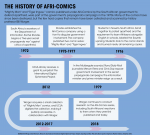Comics are gradually filling gaps in history.
Released in 1975 by publisher Afri-Comics, two comic series, “Mighty Man” and “Tiger Ingwe,” were intended to be propaganda tools used by the South African government. However, the comics were met with opposition by South Africans and nearly all copies were burned.
Despite the difficulty in finding copies today, UCLA professor of history Bill Worger said he managed to acquire a small collection from an American comics collector on eBay. Worger’s collection has since been digitized and made publicly available online because of collaborative efforts with the UCLA Library and as part of the International Digital Ephemera Project. After returning from a trip to South Africa this month, Worger said he is working to make more comics digital and researching reactions to them during the ‘70s and today. Because many have not seen the comics, Worger said the comics will provide new information, possibly explaining why the responses to the comics have been diverse.
“The combination of the visual and the storyline with the whole way it’s been put together – it’s just comics. You wouldn’t think of those as a way to investigate something that was going on,” Worger said. “It’s actually become something really illuminating.”
In 1975, as part of a propaganda campaign, the secretary of the Department of Information at the time established the company Afri-Comics, even using a front to conceal government involvement. Worger said the “Mighty Man” series was meant to appeal to an urban audience. The character himself was an African ex-policeman who wore blue tights and a cape, fought against gang members and helped victims of crime. In contrast, “Tiger Ingwe” was meant to appeal to a rural audience, featuring a superhero tiger, common imagery in South African folklore, who also used his powers to help people.
Investing nearly $3 million and hiring DC comic artists, the South African government wanted to create a propaganda item masked as an authentic piece of work from the South African community, Worger said. In addition to including quality illustrations and compelling storylines, the government included side stories that incorporated African myths, he said, such as one about a tortoise and lizard in volume 12 of “Mighty Man” and advertisements for upcoming movies.
Though the government tried to make authentic and indigenous comics, Worger said many South Africans saw through the con. During and after the uprising in Soweto, South Africa, when students banded together to protest the enforcement of Afrikaans in school curriculums, South Africans burned down newsstands and copies of the comics, Worger said.
However, despite people’s strong negative reactions to the comics in the past, present-day South Africans remain either unaware of them or have positive reactions toward them, said Sharon Farb, an associate university librarian who collaborated with Worger on IDEP. After making the comics available online, Farb said the library has only received pleasant responses and messages of gratitude, some of which have even come from South Africa.
“Making (Afri-Comics) accessible has made it possible for others who would not even have been aware this happened as a historical set of events (to experience it),” Farb said. “It’s allowed (some) to re-engage.”
In his most recent trip to South Africa, Worger said he discovered a national depository library, in which publishers were required to deposit a copy of every single publication that possessed a complete collection of the comics. But the employees at the library didn’t know the history behind them, presenting them as eccentric items in a exhibit earlier in the year.
Apart from the curators at the library, people who even lived through apartheid and in Soweto didn’t know the comics existed, said Aaron Setareh, a fourth-year history student who studied the comics in one of Worger’s courses. Setareh said he showed the comics to a friend’s father, who lived in South Africa and had friends from Soweto during apartheid, but neither the father nor his friends recognized the comics.
“He had no idea these comics existed. He was always hanging out with his African friends in Soweto,” Setareh said. “He would sneak into there. Not him or no one there knew about ‘Mighty Man’ and ‘Tiger Ingwe.'”
However, Worger said he has met some South Africans who were aware of the comics. In his 2018 trip, Worger said he went around with a physical copy of the comics and asked if anyone had read them before. His search led him to a 65-year-old man who had read the comics as a child. Upon looking at the physical copies, rather than treating them like a piece of propaganda, the man saw them as simply enjoyable comics, Worger said.
“I wasn’t going to ask him questions (like), ‘Why did you read this, what are you doing?'” Worger said. “I (said) to him, ‘I can show you on your computer where you can find all the rest of them.’ As we were leaving, he was going back to his computer and finding something of his childhood back again.”
For his current research, Worger said he wants to investigate how the South African government managed to create comics that were both authentic yet used for propaganda. He said he also wants to investigate South Africans’ reactions to the comics and why the government decided on a comic form.
“This is just another whole part of history. In a sense, a lot of people think, ‘We don’t do that, that’s not history,’” Worger said. “I don’t believe in any of these barriers. Everything is history. … These are comics, but they fit into an overall approach about why we’re interested in looking at a range of issues.”
